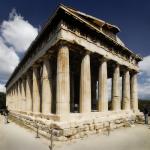|
This section contains 3,093 words (approx. 11 pages at 300 words per page) |

|
The Destruction of Pompeii.
On 24 August 79 C.E., the volcano of Mt. Vesuvius, which was thought to be extinct, reawakened and blew up, spewing a mushroom-shaped cloud into the air to the amazement and terror of the onlookers. The eruption would claim the life of Pliny the Elder who is one of the major sources for information about Greek and Roman art. When the eruption was over, the cities of Pompeii, Herculaneum, Stabiae, and Oplontis had been sealed in ash and lava. Pompeii and Stabiae were covered in easily removable ash and pumice, but Herculaneum, directly beneath the volcano, was covered with mud and lava that hardened as it cooled, making it impossible to remove without pick-axes and pneumatic drills. While the eruption was a terrible tragedy in the ancient world, it was a boon for modern art historians, for the lava preserved the wall decorations...
|
This section contains 3,093 words (approx. 11 pages at 300 words per page) |

|




